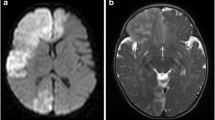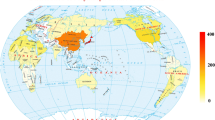Abstract
To clarify the differences between childhood-onset moyamoya disease and that with onset in adulthood, we studied the clinical course and angiographic findings of adult patients (over 20 years of age) with moyamoya disease of childhood onset (up to 15 years of age). The clinical course in 25 patients could be assessed. The follow-up period was 5–27 years. Neurological deficits were noted in 11/23 and mental disorders in 9/21. In all except one, the illness had started before the age of 7 years. Neither neurological nor mental condition changed during or after adolescence (15–20 years of age). Two patients died of intracranial hemorrhage. The disease progressed in angiographic stage until adolescence, but had stabilized or almost stabilized by the age of 20 years. This study indicates that moyamoya disease with onset in childhood carries high morbidity and mortality. The disease advances in angiographic stage between childhood and adolescence, but stabilizes or almost stabilizes between adolescence and adulthood.
Similar content being viewed by others
References
Fukuyama Y, Imaizumi T, Osawa M, Kanai N, Ishiwata M, Igarashi K, Takamura M, Umezu R (1993) A long-term prognosis of children with TIA type spontaneous occlusion of the circle of Willis (moyamoya disease) with special reference to Wechsler's intelligence test and Benton's visual retention test (in Japanese). In: Yonekawa Y (ed) The Research Committee on Spontaneous Occlusion of the Circle of Willis (moyamoya disease) of the Ministry of Health and Welfare, Tokyo, pp 101–106
Karasawa J, Touho H, Ohnishi H, Miyamoto S, Kikuchi H (1992) Long-term follow-up study after extracranial-intracranial bypass surgery for anterior circulation ischemia in childhood moyamoya disease. J Neurosurg 77:84–89
Matsushima Y, Aoyagi M, Niimi Y, Shishido T, Tamaki M, Asano T, Nariai S, Suzuki R, Hirakawa K, Yamazaki K (1992) Contents of intelligence disturbance in pediatric moyamoya disease and its post-EDAS changes (in Japanese). In: Yonekawa Y (ed) The Research Committee on Spontaneous Occlusion of the Circle of Willis (moyamoya disease) of the Ministry of Health and Welfare, Tokyo, pp 91–97
Suzuki J (1986) Moyamoya disease. Springer, Berlin Heidelberg New York
Takahashi A, Fujiwara S, Suzuki J (1986) Long term follow-up angiography of moyamoya disease-cases followed up from childhood to adolescence (in Japanese). Neurol Surg 14:23–29
Author information
Authors and Affiliations
Rights and permissions
About this article
Cite this article
Ezura, M., Yoshimoto, T., Fujiwara, S. et al. Clinical and angiographic follow-up of childhood-onset moyamoya disease. Child's Nerv Syst 11, 591–594 (1995). https://doi.org/10.1007/BF00300998
Received:
Issue Date:
DOI: https://doi.org/10.1007/BF00300998




